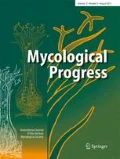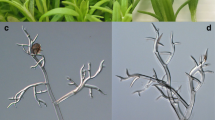Abstract
Aquilegia is a popular garden plant in the northern hemisphere as well as a native plant in the UK and continental Europe. In 2000, Semiaquilegia adoxoides was found infected by downy mildew in Korea, and since 2013 there have been several confirmed records of a Peronospora sp. affecting Aquilegia in the UK, with symptomatic plants being observed several years prior. Symptoms include yellow patches delineated by the veins on the leaves of affected plants, but systemically infected plants were also recorded, which are generally chlorotic and show curled leaf margins. A greyish down of conidiophores and conidia was observed on the lower side of infected leaves. Preliminary molecular phylogenetic analyses could not identify the causal agent at the species level, but revealed its affinities to other Peronospora species parasitic on the Ranunculales and Saxifragaceae. To our knowledge, this is the first occurrence of a downy mildew affecting a species of Aquilegia. Already, about 1 year after its confirmed first occurrence in the UK and 3 years after reported symptoms, a huge impact on infested gardens and nurseries has occurred. As oospore production has been observed and the pathogen can grow systemically, rendering seed transmission likely, this pathogen should be classified as a high risk pathogen for Aquilegia. Appropriate quarantine measures should be taken to restrict the pathogen from spreading.




Similar content being viewed by others
References
Adenle VO, Cardwell KF (2000) Seed transmission of maize downy mildew (Peronosclerospora sorghi) in Nigeria. Plant Pathol 49:628–634
Altschul SF, Gish W, Miller W, Myers EW, Lipman DJ (1990) Basic local alignment search tool. J Mol Biol 215:403–410
Basavarju P, Chaluvaraju G, Deepak SA, Amrutesh KN, Shetty HS (2004) Location and transmission of downy mildew pathogen Plasmopara halstedii in sunflower seeds. Seed Res 32:108–110
Beal E (2012) RHS science update: impatiens Downy Mildew. The Garden. May 44–45
Belbahri L, Calmin G, Pawlowski J, Lefort F (2005) Phylogenetic analysis and real time PCR detection of a presumably undescribed Peronospora species on sweet basil and sage. Mycol Res 109:1276–1287
Choi Y-J, Hong SB, Shin HD (2005) A reconsideration of Pseudoperonospora cubensis and P. humuli based on molecular and morphological data. Mycol Res 109:841–848
Choi Y-J, Hong SB, Shin HD (2007) Re-consideration of Peronospora farinosa infecting Spinacia oleracea as distinct species Peronospora effusa. Mycol Res 111:381–391
Choi Y-J, Denchev CM, Shin HD (2008a) Morphological and molecular analyses support the existence of host-specific Peronospora species infecting Chenopodium. Mycopathologia 165:155–164
Choi Y-J, Park MJ, Shin HD (2008b) Downy mildew outbreak on Chrysanthemum boreale caused by Paraperonospora minor. Plant Pathol 57:1176
Choi Y-J, Shin HD, Thines M (2009) Two novel Peronospora species are associated with recent reports of downy mildew on sages. Mycol Res 113:1340–1350
Choi YJ, Thines M, Han JG, Shin HD (2011) Mitochondrial phylogeny reveals intraspecific variation in Peronospora effusa, the spinach downy mildew pathogen. J Microbiol 49:1039–1043
Choi Y-J, Klosterman SJ, Kummer V, Voglmayr H, Shin HD, Thines M (2015) Multi-locus tree and species tree approaches toward resolving a complex clade of downy mildews (Straminipila, Oomycota) including pathogens of beet and spinach. Mol Phylogenet Evol 86:24–34
Cohen Y, Sackston WE (1974) Seed infection and latent infection of sunflower by Plasmopara halstedii. Can J Bot 52:231–238
Cohen Y, Vaknin M, Ben-Naim Y, Rubin AE (2013) Light suppresses sporulation and epidemics of Peronospora belbahrii. PLoS ONE 8, e81282
Constantinescu O (1991) An annotated list of Peronospora names. Thunbergia 15:1–110
Constantinescu O, Thines M (2010) Plasmopara halstedii is absent from Australia and New Zealand. Pol Bot J 55:293–298
Cooke DEL, Drenth A, Duncan JM, Wagels G, Brasier CM (2000) A molecular phylogeny of Phytophthora and related Oomycetes. Fungal Genet Biol 30:17–32
Cubey J, Armitage J, Edwards D, Könyves K, Lancaster N (eds) (2015) RHS plant finder. The Royal Horticultural Society, London, pp 79–81
Danielsen S, Mercado VH, Ames T, Munk L (2004) Seed transmission of downy mildew (Peronospora farinosa f. sp. chenopodii) in quinoa and effect of relative humidity on seedling infection. Seed Sci Technol 32:91–98
de Bary A (1863) Recherches sur le développement de quelques champignons parasites. Ann Sci Nat 4:1–148
Francis SM, Waterhouse GM (1988) List of Peronosporaceae reported from the British Isles. Trans Br Mycol Soc 91:1–62
Gabler J, Hagedorn G, Braun U (2012) Taxonomy and phylogenetic placement of the downy mildew Peronospora saturejae-hortensis. Mycotaxon 121:455–463
Garibaldi A, Minuto G, Bertetti D, Gullino M-L (2004) Seed transmission of Peronospora sp. of basil. J Plant Dis Plant Prot 111:465–469
Gäumann E (1923) Beiträge zu einer Monographie der Gattung Peronospora Corda. Beitr Kryptogamenflora Schweiz 5:1–360
Glimn-Lacy J, Kaufman PB (2006) Buttercup family (Ranunculaceae). Botany illustrated: introduction to plants, major groups, flowering plant families. Springer, New York, p 80
Göker M, Riethmüller A, Voglmayr H, Weiß M, Oberwinkler F (2004) Phylogeny of Hyaloperonospora based on nuclear ribosomal internal transcribed spacer sequences. Mycol Prog 3:83–94
Göker M, García-Blázquez G, Voglmayr H, Tellería MT, Martín MP (2009) Molecular taxonomy of phytopathogenic fungi: a case study in Peronospora. PLoS ONE 4, e6319
Gumedzoe MYD, Hemou P, Lepage A, Lecat N (1998) Inventaire et identification de Peronospora lamii (Al. Br.) de By, agent causal du mildiou du basilic (Ocimum basilicum) dans les exploitations de Gyma Cultures. Les VIIIe Journées Scientifiques de l’Université du Bénin, 11–15 mai 1998, Lomé, Bénin
Gustavsson A (1959a) Studies on nordic peronosporas. I. Taxonomic revision. Opera Bot Soc Bot Lund 3:1–271
Gustavsson A (1959b) Studies on the oospore development in Peronospora. Bot Notiser 112:1–16
Heller W, Baroffio C (2003) Le mildiou (Peronospora lamii) du basilic progresse! Der Gemüsebau/Le Maraîcher 8:12–13
Inaba T, Takahashi K, Morinaka T (1983) Seed transmission of spinach downy mildew. Plant Dis 67:1139–1141
Ioos R, Laugustin L, Rose S, Tourvieille J, Tourvieille de Labrouhe D (2007) Development of a PCR test to detect the downy mildew causal agent Plasmopara halstedii in sunflower seeds. Plant Pathol 56:209–218
Jang P, Safeeulla KM (1990) Modes of entry, establishment and seed transmission of Peronospora parasitica in radish. Proc Indian Acad Sci Plant Sci 100:369–373
Jennings P (2014) Continued management of impatiens downy mildew. HDC factsheet. 05/14. Horticultural Development Company, Warwickshire
Katoh K, Standley DM (2013) MAFFT multiple sequence alignment software version 7: improvements in performance and usability. Mol Biol Evol 30:772–780
Katoh K, Toh H (2008) Improved accuracy of multiple ncRNA alignment by incorporating structural information into a MAFFT-based framework. BMC Bioinf 9:212
Kitner M, Lebeda A, Sharma R, Runge F, Dvořák P, Tahir A, Choi Y-J, Sedláková B, Thines M (2015) Coincidence of virulence shifts and population genetic changes of Pseudoperonospora cubensis in the Czech Republic. Plant Pathol. doi:10.1111/ppa.12370
Landa BB, Montes-Borrego M, Muñoz-Ledesma FJ, Jiménez-Díaz RM (2007) Phylogenetic analysis of downy mildew pathogens of opium poppy and PCR-based in planta and seed detection of Peronospora arborescens. Phytopathology 97:1380–1390
Lane CR, Beales PA, O’Neill TM, McPherson GM, Finlay AR, David J, Constantinescu O, Henricot B (2005) First report of Impatiens downy mildew (Plasmopara obducens) in the UK. Plant Pathol 54:243
Lebeda A, Widrlechner MP (2003) A set of Cucurbitaceae taxa for differentiation of Pseudoperonospora cubensis pathotypes. Z Pflanzenkrankh Pflanzenschutz 110:337–349
Lefort F, Gigon V, Amos B (2003) Le mildiou s’étend. Dé jà détecté dans de nombreux pays européns, Peronospora lamii responsable du mildiou du basilic, a été observé en Suisse dans la région lémanique. Réussir Fruits Légumes 223:66
Maier W, Begerow D, Weiß M, Oberwinkler F (2003) Phylogeny of the rust fungi: an approach using nuclear large subunit ribosomal DNA sequences. Can J Bot 81:12–23
Martini P, Rapetti S, Bozzano G, Bassetti G (2003) Segnalazione in Italia di Peronospora lamii su basilico (Ocimum basilicum L.). Atti del Convegno ‘Problemi fitopatologici emergenti e implicazioni per la difesa delle colturé. Sanremo IM 27–29 Novembre 2003:79–82
Nold R (2003) Columbines: Aquilegia, Paraquilegia, and Semiaquilegia. Timber Press Cambridge
Riethmüller A, Voglmayr H, Göker M, Weiß M, Oberwinkler F (2002) Phylogenetic relationships of the downy mildews (Peronosporales) and related groups based on nuclear large subunit ribosomal DNA sequences. Mycologia 94:834–849
Runge F, Thines M (2009) A potential perennial host for Pseudoperonospora cubensis in temperate regions. Eur J Plant Pathol 123:483–4862
Runge F, Thines M (2011) Host matrix has major impact on the morphology of Pseudoperonospora cubensis. Eur J Plant Pathol 129:147–156
Runge F, Thines M (2012) Reevaluation of host specificity of the closely related species Pseudoperonospora humuli and P. cubensis. Plant Dis 96:55–61
Sackston WE (1981) Downy mildew of sunflower. In: Spencer DM (ed) The downy mildews. Academic, London, pp 545–575
Stace C (2010) New flora of the British Isles, 3rd edn. Cambridge University Press, Cambridge
Stamatakis A (2006) RAxML-VI-HPC: maximum likelihood-based phylogenetic analyses with thousands of taxa and mixed models. Bioinformatics 22:2688–2690
Stamatakis A, Hoover P, Rougemont J (2008) A rapid bootstrap algorithm for the RAxML web servers. Syst Biol 57:758–771
Tamura K, Nei M (1993) Estimation of the number of nucleotide substitutions in the control region of mitochondrial DNA in humans and chimpanzees. Mol Biol Evol 10:512–526
Tamura K, Stecher G, Peterson D, Filipski A, Kumar S (2013) MEGA6: molecular evolutionary genetics analysis version 6.0. Mol Biol Evol 30:2725–2729
Thines M, Telle S, Ploch S, Runge F (2009) Identity of the downy mildew pathogens on sage, basil and coleus, with implications for quarantine measures. Mycol Res 113:532–540
Thines M, Runge F, Telle S, Voglmayr H (2011) Phylogenetic investigations in the downy mildew genus Bremia reveal several distinct lineages and a species with a presumably exceptional wide host range. Eur J Plant Pathol 129:81–89
Viennot-Bourgin G (1981) History and importance of downy mildews. In: Spencer DM (ed) The downy mildews. Academic, London, pp 1–15
Voglmayr H (2003) Phylogenetic relationships of Peronospora and related genera based on nuclear ribosomal ITS sequences. Mycol Res 107:1132–1142
Voglmayr H, Korytnianska VG (2015) Peronospora odessana sp. nov., a downy mildew pathogen of a tertiary relict species, Gymnospermium odessanum. Mycol Prog 14:36
Voglmayr H, Rietmüller A, Göker M, Weiss M, Oberwinkler F (2004) Phylogenetic relationships of Plasmopara, Bremia and other genera of downy mildews with pyriform haustoria based on Bayesian analysis of partial LSU rDNA sequence data. Mycol Res 108:1011–1024
Voglmayr H, Piątek M, Mossebo DC (2009) Pseudoperonospora cubensis causing downy mildew disease on Impatiens irvingii in Cameroon: a new host for the pathogen. Plant Pathol 58:394
Voglmayr H, Montes-Borrego M, Landa BB (2014) Disentangling Peronospora on Papaver: phylogenetics, taxonomy, nomenclature and host range of downy mildew of opium poppy (Papaver somniferum) and related species. PLoS ONE 9(5), e96838
Waterhouse GM, Brothers MP (1981) The taxonomy of Pseudoperonospora. Mycol Pap 148:1–18
Yerkes WD, Shaw CG (1959) Taxonomy of the Peronospora species on Cruciferae and Chenopodiaceae. Phytopathology 49:499–507
Yoshida K, Schuenemann VJ, Cano LM, Pais M, Mishra B, Sharma R et al (2013) The rise and fall of the Phytophthora infestans lineage that triggered the Irish potato famine. Elife 2, e00731
Yoshida K, Burbano HA, Krause J, Thines M, Weigel D, Kamoun S (2014) Mining herbaria for plant pathogen genomes: back to the future. PLoS Pathog 10, e1004028
White TJ, Bruns T, Lee S, Taylor J (1990) Amplification and direct sequencing of fungal ribosomal RNA genes for phylogenetics. In: Innis MA, Gelfand DH, Sninsky JJ, White TJ (eds) PCR Protocols: a guide to methods and applications. Academic, New York, pp 315–322
Acknowledgments
The authors are indebted to Carrie Thomas for her expert knowledge of Aquilegia, her detailed observations regarding disease progression, for her images of symptoms, and would like to thank her for invaluable support. MT is supported by the LOEWE programme of the government of Hesse, in the framework of the Research Cluster Integrative Fungal Research (IPF).
Author information
Authors and Affiliations
Corresponding author
Additional information
Section Editor: Franz Oberwinkler
Rights and permissions
About this article
Cite this article
Denton, G.J., Beal, E.J., Kilty, A. et al. Characterisation and risk assessment of the emerging Peronospora disease on Aquilegia . Mycol Progress 14, 69 (2015). https://doi.org/10.1007/s11557-015-1092-5
Received:
Revised:
Accepted:
Published:
DOI: https://doi.org/10.1007/s11557-015-1092-5




